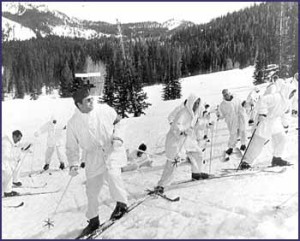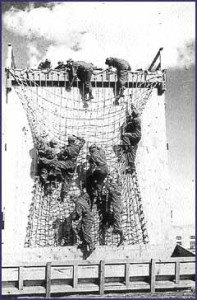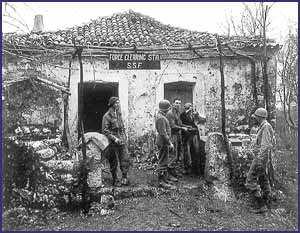This article on the Devil’s Brigade originally appeared in 2001 as part of the Missoulian newspaper’s “Greatest Generation” Series

Little fanfare accompanied the arrival of the U.S. Army’s 1st Special Service Force at Fort William Henry Harrison, just outside Helena, in July 1942. The force, considered the forerunner of today’s Green Berets, was one of the most colorful and unusual military units in American history.
The Force, a joint U.S.-Canadian unit, was designed to implement “Project Plough,” a top-secret plan to drop highly trained commandos into German-occupied Norway and disrupt that country’s industry. Col. Robert T. Frederick chose the name 1st Special Service Force, hoping that his deadly soldiers would be confused with the army detachments in charge of recreation and leisure. The Germans would call them simply, “the Devil’s Brigade.”
Helena was chosen as the training camp for the top-secret unit, and during the summer of 1942 construction workers worked furiously to ready the camp for military use.
Col. Frederick was authorized to recruit 133 officers and 1,688 men from both the United States and Canada for what was widely regarded as a suicide mission. Frederick put out a call for officers under 35 in excellent condition who were willing to learn parachute training and had experience living in the arctic or mountainous regions. Some officers were told they would have “a short and exciting life” if they volunteered. Preference would be given to “Lumberjacks, Forest Rangers, Hunters, Northwoodsmen, Game Wardens, Prospectors, and Explorers.”

Bob Plunkett of Missoula was a “newly minted” second lieutenant when the force recruiting team arrived at his Officer’s Candidate School. “I was one of those they picked,” he said.
The Canadian Army hand-picked some of its most experienced soldiers for the force. American enlisted men, on the other hand, were chosen more for their fighting ability than their education or military accomplishments. Said one enlisted man: “When they interviewed me for the force, they took me, even though I had no jail record.”
Plunkett discounted those charges. “You may have seen that movie that pictured us as a bunch of jailbirds,” he said. “That was totally untrue. Neither Army accepted any convicts in the first place.”
Nevertheless, the force was a colorful bunch by anyone’s reckoning. The men of the 1st Special Services Force began arriving in Helena in July 1942. Although the kilts and berets worn by some of the Canadians raised eyebrows among the Americans, Plunkett remembers that, “we got along fine with them. After awhile, as far as I was concerned, even with the men in my platoon, I had to think twice to tell you which one was American and which one was Canadian.”
By mid-August 1942, most of the force had been assembled and the camp was taking shape. The forcemen shattered a number of windows in Helena while enthusiastically practicing their demolition skills, but the mayor refused to bill the Army. Broken glass was only one of many contributions Helena citizens would make for the war effort.

The U.S. and Canadian soldiers of the 1st Special Service Force spent their days parachuting and learning to ski on the Continental Divide, and their nights practicing hand-to-hand combat skills against each other and the local cowboys and miners. The residents of Helena adopted the forcemen as their own. They regularly watched the parachute training and sometimes invited the soldiers home for Sunday supper. Almost 200 marriages took place between local girls and the forcemen.
Plunkett remembers, “Well, we trained and trained and trained. In Helena we had parachute training, and military skiing and mountaineering, whatever they could think of. We were there from July 1942 till around April the next year.”
According to Plunkett, parachute training “was pretty brief. We didn’t go through as much as the regular paratroops did. Two jumps and you qualified. They brought over some Norwegian Army officers that had escaped from occupied Norway, and they trained us on cross-country skiing.” At the end of the training, each man could ski 30 miles a day carrying a loaded pack and rifle. They also trained with a prototype of the snowmobile known as a Weasel. “We used them for running around in the snow.”
Most of this training would never be used, however. At the insistence of the Norwegian government-in-exile, who feared that their country’s infrastructure would be destroyed by the force, the army canceled Project Plough. The forcemen would never use their parachute training, their skiing skills, or their beloved Weasels.
On April 6, 1943, the 2,300 men of the 1st Special Services Force paraded through the streets of Helena. They were bound for the Aleutian Islands, where they were now assigned to assault the Japanese-held island of Kiska. Only after the forcemen paddled ashore in rubber boats did they discover that the Japanese had evacuated the island.
From there, the men of the 1st Special Services Force were sent to North Africa, and on to Italy, where the well-fortified Germans were dug into the mountains of Italy.
In a night assault on the second of December, the Forcemen attacked a German stronghold on Monte La Difensa. Using ropes, 600 men climbed all night, surprised the German garrison and captured the peak in a fierce two-hour fight. Their winter training at Helena proved invaluable as the forcemen attacked one German stronghold after another in the steep mountains of Italy. They excelled at the hand-to-hand combat in the frozen mountains.
The 1st Special Forces captured Mount Radicosa during the battle of Cassino, but took so many casualties that by Jan. 17 only a quarter of the men were fit for combat. The rest were dead, wounded or missing. They were relieved for a few days of well-deserved rest.
The 1st Special Services Force hit the beaches of Anzio in February, and the unit quickly became legendary. The forcemen darkened their faces and spent their nights patrolling behind enemy lines, and the Germans quickly learned to fear the “Black Devils of Anzio.” It was also at Anzio that Bob Plunkett stepped on an anti-personnel mine and lost his leg.

On May 23, the Allied troops broke out of the beachhead at Anzio, and the 1st Special Services Force spearheaded the attack, leading the way into Rome on June 4, 1944.
Nine weeks later, Allied forces, including the First Special Services Force, landed in southern France. The Forcemen assaulted two German-held islands, then moved along the French Riviera, helping to liberate Nice and Cannes.
By this time the force was a mere shadow of the unit that had left Helena. Four hundred forcemen were dead, nearly everyone had been wounded at least once, and few Helena veterans were still with the Force. In an emotional ceremony on Dec 5, 1944, the force gathered near the Loup River in France to disband. The force flag was furled, then the Canadians split into a separate battalion. Their epitaph may have been written by a 3rd Division soldier, who told Yank magazine, “The 1st Special Service Force are the best goddamned fighters in the world.”
Many of the forcemen who trained at Helena returned to Montana after the war, including Bob Plunkett. The veterans of the 1st Special Service Force still hold reunions each year, and although time has diminished their numbers, hundreds of forcemen and their spouses and children are expected to attend the next reunion, scheduled for August 2002 in Helena.
Devil’s Brigade awarded the Congressional Gold Medal
Read about the death of the last two members of the Devil’s Brigade living in Montana.
Senator Max Baucus introduced a Senate resolution to honor members of the First Special Service Force.
Need more information of the First Special Service Force? Check out Montana’s Home Front During World War II.




My grandfather Jerald L. Curtiss was in SV Co 474 infantry he was never given his Congressional Medal of Honor because he died at a young age from cancer he refused to not work and not support his family he was at work with his dying breath his loving family carried on I am 32 years old I would be his grandson I was unaware of what he did in the war because that’s what he wanted I feel that he should have his metal alive or not he felt he never should have been home from the war he should have died with everyone else but he made it home and had a family he didn’t care about recognize ation but I feel he needs to be recognized for the things he has done I know he loved his country and he loves his family he risked and gave his life for both please contact me curtissj3@gmail.com thank you
I would send pictures of The Meadows the patches I have a book and everything to prove he is who he is but it won’t let me put it on here